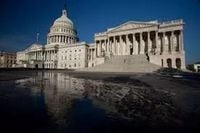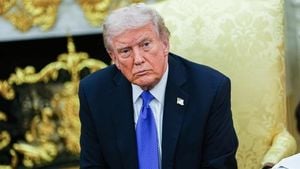On October 1, 2025, the United States government plunged into its 15th shutdown since 1981, as deep partisan divisions between Congress and the White House halted much of the nation’s federal operations. The standoff—rooted in a bitter clash over funding and health care—has already sent shockwaves through federal agencies, financial markets, and the daily lives of millions of Americans.
The immediate consequences were swift and severe. According to Reuters, the shutdown led to the furlough of 750,000 federal workers, costing the government an estimated $400 million per day. Essential employees, such as air traffic controllers and Transportation Security Administration staff, continued to work without pay, while others were placed on unpaid leave. The release of September’s crucial employment report was halted, scientific research suspended, and U.S. troops faced pay delays. Even the nation’s parks and museums closed their doors, inconveniencing travelers and families alike.
The Department of Housing and Urban Development (HUD) became a flashpoint in the unfolding drama. As reported by Federal News Network, a mass email circulated across several agencies, including HUD, instructed employees not to blame President Donald Trump for the funding lapse, but rather to place responsibility on congressional Democrats. HUD’s website went so far as to declare, “Radical Left are going to shut down the government and inflict massive pain on the American people unless they get their $1.5 trillion wish list of demands.” This unusual public statement mirrored the broader administration messaging and underscored the agency’s pivotal role during the crisis.
For HUD and the communities it serves, the stakes could hardly be higher. The agency oversees vital programs—rental assistance, homelessness support, and fair housing investigations—that directly impact millions of low-income Americans. Past shutdowns have forced HUD to delay payments to landlords in Section 8 programs, freeze housing grants, and halt investigations, destabilizing fragile support networks that nonprofits and local agencies depend on. This time, the uncertainty was palpable, with many HUD employees facing furloughs and community partners anxiously awaiting word on when funding might resume.
The political messaging emanating from HUD sparked renewed debate over the Hatch Act, a federal law prohibiting partisan political activity by government employees in their official capacities. Legal analysts noted that using agency channels to assign political blame could raise compliance issues. The Office of Special Counsel, which enforces the Hatch Act, had yet to comment, but watchdog groups warned that politicizing agencies like HUD risks eroding public trust. Critics argued that such communications distracted from HUD’s mission of supporting affordable housing and community development, while administration supporters insisted the messaging simply reflected the political reality behind the impasse.
Meanwhile, the broader funding dispute centered on a proposed $1.7 trillion for agency operations—about a quarter of the government’s $7 trillion total budget. The remainder, as Reuters detailed, goes to mandatory programs like health and retirement, and to interest payments on the ballooning $37.5 trillion national debt. The Senate had rejected a short-term spending measure that would have kept the government running through November 21, 2025. Democrats blocked the bill, citing Republicans’ refusal to extend health benefits for millions of Americans set to expire at year’s end. Republicans, for their part, insisted that health care should be addressed separately.
President Trump, whose administration has already moved to shrink the federal workforce by an estimated 300,000 jobs by December, warned that the shutdown could clear the way for “irreversible” cuts to jobs and programs. His budget director, Russell Vought, echoed that sentiment, threatening permanent layoffs if the standoff persisted. The hardline approach drew sharp rebukes from Democrats. Senate Democratic leader Chuck Schumer fumed, “All they want to do is try to bully us. And they’re not going to succeed.” He also blasted a deepfake video circulated by Trump that mocked Democratic leaders, calling it “childish” and “petty.” Schumer added, “It’s something that a 5-year-old would do, not a president of the United States. But it shows how unserious they are. They don’t give a damn about the harm they will cause with their shutdown.”
On the other side, Senate Majority Leader John Thune described the failed spending bill as “nonpartisan” and blamed the shutdown squarely on politics, remarking, “What’s changed is, President Trump is in the White House. That’s what this is about. This is politics. And there isn’t any substantive reason why there ought to be a government shutdown.” Despite holding majorities in both chambers, Republicans needed at least seven Democratic votes in the Senate to pass any funding legislation—a tall order in the current polarized climate.
The shutdown’s ripple effects quickly spread beyond Washington. As Khaleej Times reported, global markets were rattled, with investors flocking to safe-haven assets like gold and the Japanese yen. The U.S. dollar weakened, putting pressure on dollar-pegged currencies such as the UAE dirham, which, while stable by policy, could see imported inflation and shifts in purchasing power if the dollar’s slump persists. Gold prices soared, buoyed by both central bank buying and China’s efforts to promote gold and the yuan as alternatives to the dollar in trade settlements. Mining stocks also benefited, with London-listed Fresnillo’s shares surging over 300% since January and Zijin Gold International’s IPO jumping 68% at debut.
For equities, the picture was less clear. The S&P 500 has historically gained during most past shutdowns, including a 10% rise during the 2018-2019 standoff. Still, the current deadlock delayed the release of key U.S. economic data, including the all-important jobs report, leaving markets in suspense and heightening uncertainty about the Federal Reserve’s next move.
Since 1976, the U.S. has weathered roughly 20 shutdowns, most lasting less than a week. Yet each episode chips away at confidence in Washington’s ability to manage its fiscal affairs. University of Chicago professor Robert Pape observed, “The rules of politics are radically changing and we can’t know for sure where all of this is going to end.” He noted that the growing power of the extreme wings in both parties makes compromise even harder, with each side reluctant to backtrack against “tens of millions of truly aggressive supporters.”
As the days tick by, the human cost of the shutdown mounts. Federal employees and their families face financial hardship, while millions who rely on government programs—from housing to food assistance—are left in limbo. The debate over HUD’s political messaging has reignited calls to clarify the boundaries of official speech and reform shutdown procedures altogether.
For now, the nation waits—watching, worrying, and wondering how long the standoff will last, and what the ultimate price will be for America’s political dysfunction.





